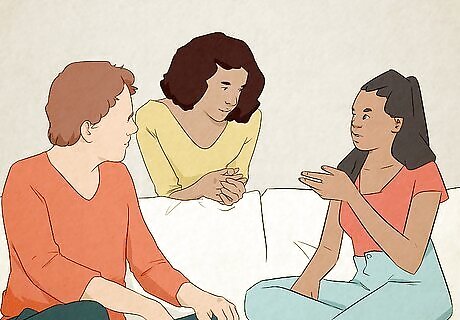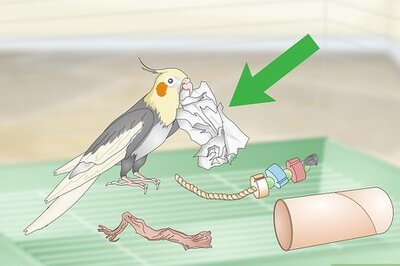
views
- Ask yourself if you feel romantically attracted to women. Does the thought of dating a woman excite you?
- Identify any sexual attraction you feel for women, such as feeling aroused by them or having sexual fantasies involving women.
- Take a sexual orientation quiz, such as the Kinsey Scale Test, to help you get a broad sense of your sexual preferences.
Identifying Your Sexual Preferences

Evaluate why you are questioning your sexual orientation. The decision to explore your sexual orientation is a personal choice and is completely normal. Take some time to reflect on what caused you to start questioning your sexual orientation and why you’re particularly interested in lesbianism. Write your thoughts down in a journal or talk to someone you trust. Some questions to ask yourself include: When did I start questioning my sexual orientation? Is there a specific event or person that made me start having these thoughts? Am I questioning my sexual orientation because I’m genuinely curious, or because people already assume I’m lesbian?

Look for signs that you are romantically attracted to women. The term “romantic attraction” refers to a person’s desire to be romantically involved with someone. Things like wanting to date another woman and be in an exclusive relationship with them are signs that you might be romantically attracted to them. Consider the following: Does your stomach feel like it has butterflies in it when you see a woman you like? Do you find yourself thinking about other women often and wanting to be close to them? Does the thought of dating, holding hands, and doing other romantic things with a woman excite you? Do you find yourself not very interested in straight relationships that appear in movies, books, or TV shows? Have you ever flirted with a woman?

Identify any sexual attraction you feel towards women. Sexual attraction refers to a person’s desire to have sexual relations or interactions with someone. Think about these questions to help figure out whether you feel this type of attraction: Do you think certain women look hot? Are you sexually aroused by women? Do you like to imagine what women would look like if they were naked? Do you prefer to kiss and have sex with women? Women who identify as lesbian can be sexually attracted to other women, romantically attracted, or both.

Take a sexual orientation test. If you’re struggling to identify your sexual preferences, taking a sexual orientation test may help you work through your thoughts and offer some clarity. Take wikiHow’s “Am I a Lesbian Quiz” as a starting point. Some other quizzes to take include: Epstein Sexual Orientation Inventory (ESOI) test: The ESOI test evaluates an individual’s sexual orientation. Instead of labeling your sexual orientation, the test results reveal where you fall on a sexual orientation continuum, ranging from “Opposite Sex Attraction” to “Same-Sex Attraction.” The Kinsey Scale: The Kinsey Scale ranks you on a scale of 0 to 6 based on your sexual history, with 0 being “exclusively heterosexual” and 6 being “exclusively homosexual.” There is an additional X ranking, which defines people who haven’t had any sexual relations or reactions. There is no “official” Kinsey Scale Test made by the Kinsey Institute. However, there are many tests online that use the Kinsey Scale to evaluate someone’s sexual orientation.
Accepting Your Identity

Acknowledge your sexual and/or romantic preferences. Acknowledging doesn’t necessarily mean accepting. You may still have some doubts or questions regarding your sexual orientation, but the important thing is that you’re pursuing these questions and acknowledging your feelings. Talk with others you feel safe with, journal, or read through online forums to keep learning about yourself and your preferences. Sexual and romantic orientations exist along a spectrum. Your sexual preference may not align with the standard definitions and that’s more than okay. There’s no singular definition when it comes to sexual and romantic attraction.

Be honest with yourself first and tell yourself you are a lesbian. On the journey towards establishing your sexual identity, accepting that you are a lesbian is the first step in a gradual process. Acceptance often doesn’t happen overnight. Saying to yourself “I am a lesbian” might relieve a lot of stress and pressure and allow you to move forward in your journey.

Practice self-love and speak to yourself positively. Use positive affirmations to remind yourself that you’re someone who is worthy of love and that your sexual identity is valid. Replace any negative self-talk tendencies with positive affirmations such as: “My feelings are valid.” “I deserve to be able to love and be loved.” “I am allowed to make decisions that I think are best for me.” “I am proud of who I am.” “I know myself better than anyone.”

Determine if it is safe to come out. Deciding when to come out can be very emotional and difficult for some people. Before coming out to your family, friends, or classmates, determine if it is safe and something you really want to do. You’re not obligated to come out to anyone. Your identity is valid whether or not you decide to tell others. If your family or peers are openly hostile towards queer people, be cautious and selective about coming out. Remember that you don’t have to come out to everyone. It’s more than okay if you want to be selective about who you come out to so that you can ensure you have a good and healthy support system. Your identity is valid and worthy regardless of how a person reacts to your coming out.

Meet with a counselor if you’re looking for professional help. Meeting with a qualified therapist—a professional experienced in counseling members of the LGBTQ community—gives you a safe space to work through your thoughts and feelings. A therapist can help you accept your sexual orientation, and they may also assist you through the process of coming out to your family and peers.
Living Authentically

Learn about the lesbian community and your place within it. The lesbian community is made up of diverse women from a multitude of backgrounds. Make an effort to learn anything and everything there is to know about your new community by talking to others and doing your own research. Over time, you will discover where you fit in the community. Get involved in organizations and communities exclusive to people who identify as lesbian. Some examples include the National Center for Lesbian Rights, the Gay Center, and the Trevor Project.

Educate yourself about the LGBTQ+ community. Establishing a foundation of knowledge about the LGBTQ+ community—its past, present, and future—will enlighten you and hopefully help you discover even more about your identity. Educating yourself might make you feel more connected to the LGBTQ+ community and help you take pride in being a lesbian. Learn how to distinguish between sex, gender, and sexual orientation, and familiarize yourself with the sexual orientation spectrum. Read academic literature and books about LGBTQ+ issues and experiences. Stay up-to-date on LGBTQ+ issues covered in news. Talk with other members of the LGBTQ+ community to learn about their experiences and opinions on certain issues.

Surround yourself with supportive people. These might be friends, family members, teachers, support group members, or even online acquaintances. Find people who will be there to cheer you on as you embark on this journey and support you through both the highs and lows. If you have worries or are feeling stressed, don’t hesitate to reach out to the people you trust. Attending an LGBTQ+-affirming church, temple, or house of worship is a great way to meet supportive people and allies who share your religious beliefs. gaychurch.org provides a list of LGBTQI-affirming Christian churches.

Establish or join a Gay-Straight Alliance. Gay-Straight Alliances (GSA) provide high schoolers and middle schoolers with a safe place to discuss and discover their sexual orientation and identity. GSAs provide teens with a support group and a social network. If your school does not have a GSA, work with school administrators to establish a club.

Utilize your nearest LGBTQ+ Resource Center. LGBTQ+ Resource Centers are found in cities and on college campuses. Resource centers connect students and other community members with helpful tools and trustworthy services. They provide LGBTQ+ community members with a safe, inclusive place to explore their sexual orientation and identity. Use www.lgbtqcenter.org to find a center near you.




















Comments
0 comment